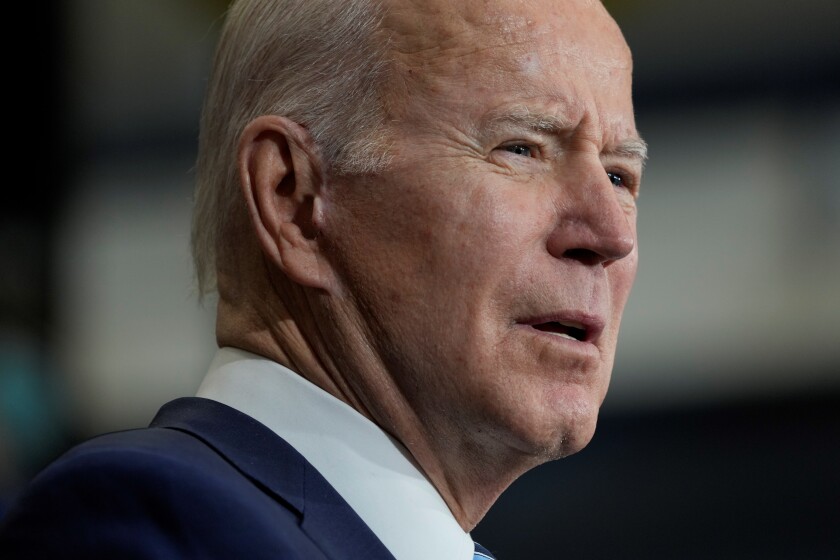President Joe Biden’s vow to overhaul the asylum process remains unfulfilled as he enters his second year — as does his promise to deal with the factors in Central America that have prompted millions in recent years to flee for the United States.
Biden vowed to “reassert America’s commitment” to asylum-seekers and refugees by easing Trump administration policies that had limited eligibility for seeking asylum, doubling the number of immigration court employees, sending more asylum officers to the border, and creating a system for people to apply for asylum while in their home country.
“Reforms to the asylum process have been rather superficial,” Krish O’Mara Vignarajah, president and CEO of Lutheran Immigration and Refugee Service, wrote in an email.
“They weren’t able to get as far last year as they wanted mainly because they were dealing with people actually arriving,” said Theresa Cardinal Brown, managing director of immigration and cross-border policy at the Bipartisan Policy Center think tank in Washington.
Biden was pushed early on in his first year to stop employing a pandemic public health measure, Title 42, mandating that Border Patrol agents turn all illegal crossers away. He had promised to end Title 42 as soon as the coronavirus was no longer a serious threat, but the spikes in cases last year prevented him from doing so.
“The fact that there were more than a million such expulsions — without so much as an interview or court hearing — speaks volumes to promises yet to be fulfilled to restore asylum protections,” said Vignarajah.
While 1 million were returned south of the border, more than 600,000 people were released into the U.S. in fiscal year 2021, which ended in September. The U.S. chose to release many migrants into the U.S. because Mexican states have refused to accept back migrants from many countries in Central America. The U.S. is stuck between returning people to their home country, releasing them into the U.S., or detaining them in immigration jails.
Countries such as Venezuela, Cuba, and Nicaragua significantly limit the number of repatriation flights from the U.S., and given the Biden administration’s opposition to immigrant detention and the lack of space amid the coronavirus pandemic, releases have been the only solution.
Aaron Reichlin-Melnick, policy counsel at the American Immigration Council, said where the Biden administration failed over the past year was in not foreseeing these problems or planning a response.
“We’re going on year three of the pandemic, and the administration has doubled and tripled down on Title 42 rather than putting in place a process to process asylum-seekers safely and humanely,” said Reichlin-Melnick. “The problem is often one of perception and chaos, and the administration needs to be focusing really hard on reducing that chaos.”
The Biden administration made a “good-faith effort” to end another Trump-era policy that Democrats hated because it banned the admission of asylum-seekers, the Migrant Protection Protocols, said Vignarajah, whose organization works with asylum-seekers after they make it to the border. Under MPP, also known as “Remain in Mexico,” migrants who sought asylum had to remain in Mexico for months until their day in court. Biden ended it in June but was forced to restart it in late 2021 following a Supreme Court order that followed lawsuits from GOP-led states.
Leidy Perez-Davis, policy director for the Asylum Seeker Advocacy Project, said the problems for asylum-seekers did not end at the border.
“It is still nearly impossible for most individuals fleeing persecution to seek safe haven in the United States. For those asylum-seekers like ASAP’s members, the Biden administration has made it extremely difficult to get a work permit and Social Security number despite obvious benefits to the economy during an historic labor shortage,” Perez-Davis wrote in an email.
Biden also has not delivered on his promise to tackle the root causes that prompt hundreds of thousands of Central Americans to travel to the U.S. southern border every year. Vice President Kamala Harris was tapped to lead that effort by coming up with and implementing a regional strategy to boost security and prosperity in the region so that people would not leave.
“While VP Harris has visited the region and will do so again this month, it is clear that the inter-agency task force she was tasked with standing up has gotten off to a slow start, and so far has produced few visible results,” Doug Farah, senior visiting fellow who studies Central America for the National Defense University’s Institute for National Strategic Studies, wrote in an email.
The White House in July 2021 issued its strategy for dealing with root causes prompting people to flee, and a Council on Transnational Organized Crime was announced. Neither has resulted in significant progress in the Northern Triangle countries of El Salvador, Guatemala, and Honduras. Empty ambassadorships in those countries have also made high-level engagement with leaders difficult, Farah said.
U.S. corporations have pledged $1.2 billion worth of commitments in the region in an effort to provide jobs to people who leave because of the lack of work opportunities. Biden also pledged $4 billion in foreign aid to Central America but needs to be careful in selecting government agencies to send the money to given the corruption across those governments, Farah said, noting how the Salvadoran government has tried to spy on journalists and human rights workers. Even without corruption concerns, the money for either endeavor will not be sent overnight.
Although migrants from Mexico and Central America make up roughly 75% of all illegal immigrants at the northern, southern, and coastal borders, far more people from other countries are arriving. Some have traveled thousands of miles and across oceans for the chance to get into the U.S., predominantly by walking across the southern border. Over the past two years, Border Patrol agents nationwide have encountered significantly more people from the Caribbean, Central Europe, and South America.
“It is no small feat to tackle corruption, political instability, economic desperation, and climate disaster all at once. Alleviating the factors that force families to flee will be critical to achieving a safer and more prosperous Central America,” said Vignarajah. “The Biden administration must continue to build on these efforts over the long-term, knowing that these initiatives take time to bear fruit. It may take years.” (https://www.washingtonexaminer.com/policy/biden-enters-second-year-with-migration-plans-for-central-america-unfulfilled)



































